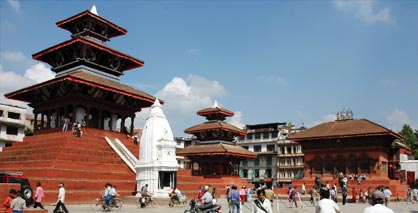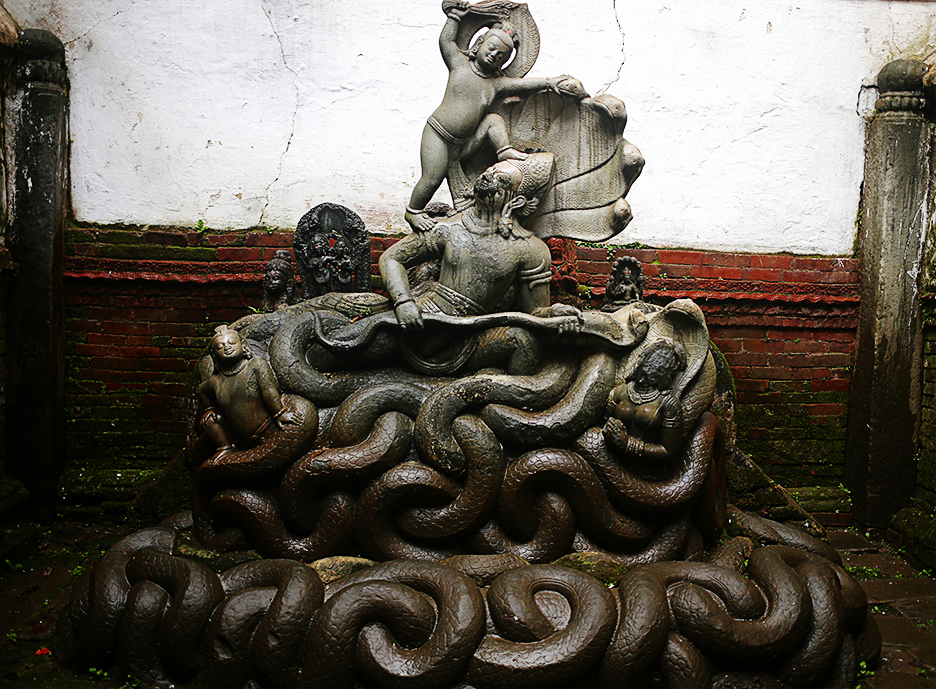
Adorning the prestige of royalty and cultural heritage, the Hanuman Dhoka Palace is the symbol of past glory of the Malla kings and the shah kings that have been passed on for centuries. This ancient Hanuman Dhoka Palace situated in the middle of the old city is also listed by the UNESCO World Heritage sites. The historical and cultural tradition of a country plays an important role in the formulation of art-tradition. The pristine palace has seen the rise and fall of many kings from Mallas
dynasty to the shah dynasty. The king followed the prominent sects of Hinduism and Buddhism, and has contributed their utmost possible for the construction of temples, palaces sometimes stupas and monasteries and these were readily beautified with the sculptures and paintings of gods and goddesses. The palace was residence of the Shah dynasty until 1886, when the royal residence was moved to the Narayanhiti Palace. This large square is the historic seat of the Nepalese Royalty. The Square, with its old temples and palaces, epitomizes the religious and cultural life of the people. It is here where Kings of Nepal were crowned. With several complexes connected together spreading in about five acres explicates the rich art and craft of that time. It has ten courtyards flourishing with the statues and artifacts of the time. King Pratap Malla enlarged the original building in the 17th century, adding many of the temples. The oldest part of the palace is Sundari Chowk and Mohan Chowk in the north part of the palace. In 1768, after Prithvi Narayan Shah took over the valley he built four lookout towers in the southeast part of the palace.
The hanuman dhoka durbar complex is a blend of the various styles of architectural monuments that are prevailing in Nepal. The pagoda style of architecture which is purely a Nepalese style generally is a multistoried complex built using bricks, woods and mud and that can be mostly seen in the square. There are also few temples constructed in the Shikhara architecture in which the pinnacles look like a mountain tops. The house of the living goddess kumari is built in the vihara architecture. The various temples are exclusively decorated with the intricate wooden arts, sculptures, paintings etc. 2015 earthquake had made major damage in the Hanuman Dhoka Durbar Square in comparison to the other durbar complex. However, we are in the phase of renovation and re-construction of the temples and structured that have been destroyed. Most of the temples at the Hanuman Dhoka durbar square are opened for the tourists. The interesting things to see in the Square are:
Trilokya Mohan Temple
 Aside of the temple of goddess Kumari stands a temple of god Trilokya Mohan’s temple. During the festival of Indrajatra, this temple plays an important role as the people portray the 10 different incarnation of the Lord Vishnu. The temple is locally known as Das Avatar Deval. Form the architectural point of view this temple is very interesting. This temple is structured in a typical Nepali style. The temple stands on 5th plinth and has 3 storied roofs made of tiles. In front of the western entrance of the temple the statue of Garuda is placed. The statue of garuda has its own importance as it shows the culture and tradition of Lichchhavi period. This statue is the replica of the statue at Changu Narayan, Hadigaun Satya Narayan Sthan and Narayan Hiti Narayani Sthan.
Aside of the temple of goddess Kumari stands a temple of god Trilokya Mohan’s temple. During the festival of Indrajatra, this temple plays an important role as the people portray the 10 different incarnation of the Lord Vishnu. The temple is locally known as Das Avatar Deval. Form the architectural point of view this temple is very interesting. This temple is structured in a typical Nepali style. The temple stands on 5th plinth and has 3 storied roofs made of tiles. In front of the western entrance of the temple the statue of Garuda is placed. The statue of garuda has its own importance as it shows the culture and tradition of Lichchhavi period. This statue is the replica of the statue at Changu Narayan, Hadigaun Satya Narayan Sthan and Narayan Hiti Narayani Sthan.
Kastha Mandap/ Maru Satal

Kastha Mandap is locally known as Maru Satal. This huge long temple has a long history. The Kastha Mandap was built from the wood of this single tree; and the name Kathmandu was derived from Kastha Mandap. Three-storey Kastha Mandap has an open ground floor, underlining its original purpose as a public building. The decorations and carvings added over the years have greatly enhanced the original design, bringing it closer to the appearance of a shrine. The central image of Kastha Mandap is of the saint Gorakhnath. At reach of the four corners is an image of Ganesh, the elephant headed god.
Kavindra Puri
In the east-south direction from the Kasthamandap, we can find a three storied building named as Kavindra puri or a temple of Nasal devata which is placed in the ground floor. The building was built by King Pratap Malla during his regime. In the ground floor of this building, we can find the sculpture of Natyeshwor Shiva which is also named Nasal Devata. The temple of Nasal Devata also known as Kavindrapur is constructed in a different way than the other temples found in the valley. We can see beautifully carved windows and doors only at the front face of temple from the other side the temple looks as if it is a housed.
Singha Satal
At the south of Kasthamadap, we can see a square shaped three storied building named Singha Satal. A-like Kasthamandap this building was also constructed in the form of Pati & Pauwa. We can see four griffins at the four corners of the first floorNow-a-days the ground floor consists of different shops. The top floor of the building is kept open as like in pati & pauwa, balcony is made. On the basis of the legend it is believed that this satal is constructed with the remaining wood after the construction of Kasthamandap.
Laxmi Narayan Temple
At the east north direction of Kasthamandap, we can see the three storied temple of Laxmi Narayan. But in the past this was constructed in the form of pati & pauwa alike Kasthamandap and Singha Satal. On the top floor of this temple, we can find the statue of Vishnu which was established during the 19th Century. Likewise we can find the sculpture of A “Hanuman” and “Mahankal” in the ground floor.
Maju Deval
At the west north direction of Trilokya Mohan temple, we can find a huge temple named as “Maju Deval”. This temple stands on the ninth plinth. After the temple of Taleju and Degu Taleju, this is the third tallest temple that we can find within the Hanuman Dhoka premises. There are a total of four doors to the temple and entering the temple we can find a huge Shiva lingam. The stone stairs are made from the bottom of the temple to its top. This is the best place from where you get an opportunity to see the beautiful picturesque of the valley.
Bhagwati Temple
This temple was build long before the conquest of Kathmandu. The image of Mahipatindra Narayan was subsequently stolen in 1766, and the shrine was empty when King Prithvi Narayan Shan entered the city in 1768. Since, Prithvi Narayan Shah had with him to place it in this empty sanctuary close to the palace. In April each year it is taken on a visit back to Nuwakot, some fifty seven Kilometers north of Kathmandu and returned a few days later.
Shiva Parvati Temple

At the south face of the temple of Trilokya Mohan the temple of shiva parvati exists. This temple is constructed in the Nepalese form of architecture; still there is some importance of this temple. This temple stands on two plinth the first plinth is very big where different functions are carried out in this plinth. We can find two big statue of lion standing at the door steps to enter the temple in order to guard it. The second floor of temple is elaborately decorated with different kinds of wooden arts. The interesting part is that, the center window consists of the wooden sculpture of Shiva and Parvati looking outside the window. It looks like they are keeping eye on each and every one passing by.
Big Bell
 The big bell is situated near the temple of Shiva Parvati. Shree Pancha Rana Bahadur Shah gave an order to construct this bell. This bell is situated almost at the second floor. This bell is said to have placed here to protect the city from the ghosts and thieves.
The big bell is situated near the temple of Shiva Parvati. Shree Pancha Rana Bahadur Shah gave an order to construct this bell. This bell is situated almost at the second floor. This bell is said to have placed here to protect the city from the ghosts and thieves.
Swet Bhairab
At the ground floor of the temple of Degu Taleju, we can see a grand sculpture of Swet Bhairab. The sculpture is covered by beautifully carved wooden windows which is only opened during the festival of Indra Jatra. Bhairab is said to be the reincarnation of Lord Shiva and is considered the most powerful amongst all. The statue of Swet Bhairab portrays big eyes, long hair, and very sharp teeth. Mostly the whole bodily feature is portrayed in the statue of Bhairab, but the statue of Swet Bhairab displayed during the Indra Jatra festival only portrays head to neck. There is the tradition of pouring alchoholic liquor from the mouth of Bhairab is one of the attraction of the festival. Swet Bhairab is decorated with garland of serpents and skulls, which looks very dangerous.
Krishna Temple
In the north- west corner opposite of the temple of Degu Taleju situated is the temple of Lord Krishna. This temple was made by King Pratap Malla during 1705 B.S. In the memory of his queens, King Pratap Malla built Krishna Temple in the Durbar Square. This temple is built in the octagonal shape which stands in the fifth plinth. To reach the top floor stone stairs are placed.
Big Drum
At the left side of Krishna temple we can see two big drums placed in the building constructed in the form of pati & pauwa. While worshipping goddess Degu Taleju these big drums are beaten.
Jagannath Temple
In front of Krishna temple situated is the temple of Jagan Nath. While entering the temple from the eastern gate the statue of Jagannath (Krishna, Subhadra & Balram’s) is placed because of which the temple is known as Jagannath temple. One can see the intricate and artistic wood carvings in the struts of the temple which is generally kept to support the roofs.
Pratap Dhoj
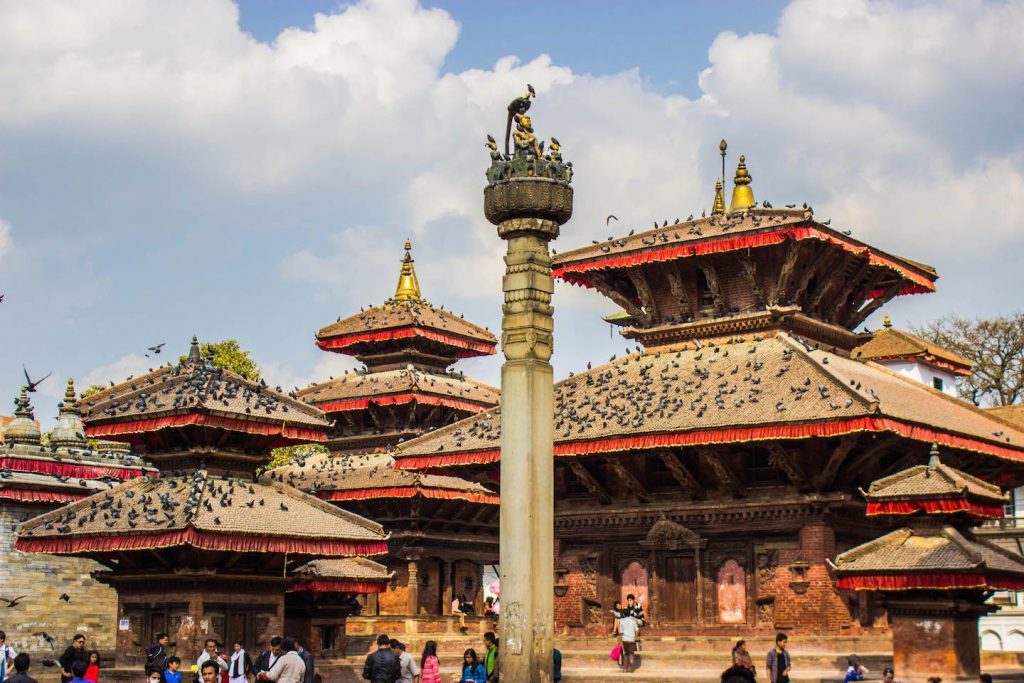 Between the temple of Jagannath and Krishna temple, a tall pillar is erected. In this pillar the golden sculpture of Pratap Malla and his two sons are placed. The pillar in-front of Degu Taleju reflects his belief towards the temple. The pillar is entirely made up stone and well sculptes as you can see the top portion of the pillar is in circular form where we can see the statue of tiger, lion, sheep, heads, etc. looking as if they are looking downwards to the people. The very top consists of the flower upon which the golden royal chair is kept. On the four corners four prince are situated, queens are seated doing the prayer and a statue of King Pratap Malla in the centre. If seen carefully we can see a small statue in between the two queens which shows the existence of a total of eight human features on the Pratap Dhoj. The pillar consists of King Pratap Malla, on the right side Queen Priyadevi, on the left side Queen Prabhabati Devi and the five other statues resembles five Prince Bhupendra Malla, Chakrabatendra Malla, Mahipatendra Malla, Nripendra Malla and Parthibendra Malla.
Between the temple of Jagannath and Krishna temple, a tall pillar is erected. In this pillar the golden sculpture of Pratap Malla and his two sons are placed. The pillar in-front of Degu Taleju reflects his belief towards the temple. The pillar is entirely made up stone and well sculptes as you can see the top portion of the pillar is in circular form where we can see the statue of tiger, lion, sheep, heads, etc. looking as if they are looking downwards to the people. The very top consists of the flower upon which the golden royal chair is kept. On the four corners four prince are situated, queens are seated doing the prayer and a statue of King Pratap Malla in the centre. If seen carefully we can see a small statue in between the two queens which shows the existence of a total of eight human features on the Pratap Dhoj. The pillar consists of King Pratap Malla, on the right side Queen Priyadevi, on the left side Queen Prabhabati Devi and the five other statues resembles five Prince Bhupendra Malla, Chakrabatendra Malla, Mahipatendra Malla, Nripendra Malla and Parthibendra Malla.
Degu Taleju
The temple of Degu Taleju is situated in front of the Pratap Dhoj. Amongst all the temples in the Durbar Square area, this temple of Degu taleju is the second tallest after the temple of goddess Taleju. The ‘torana’ or tympanum, a wooden structure placed above the main entrance of the temple displays the figures of the serpents, flower, kalash, Munda Mala (Skull Garland) and the images of gods and Goddesses. The main door can be viewed through the streets and hence is decorated with silver. The strut of the temples consists of the well carved images of Shiva and Parvati and the bottom image is of the god and goddesses having head of animals and birds. The temple of Taleju and Degu Taleju consists of the images of goddesses influenced by Shaktaism and hence are the most respected goddesses during the Malla period.
The Image of Kal Bhairav
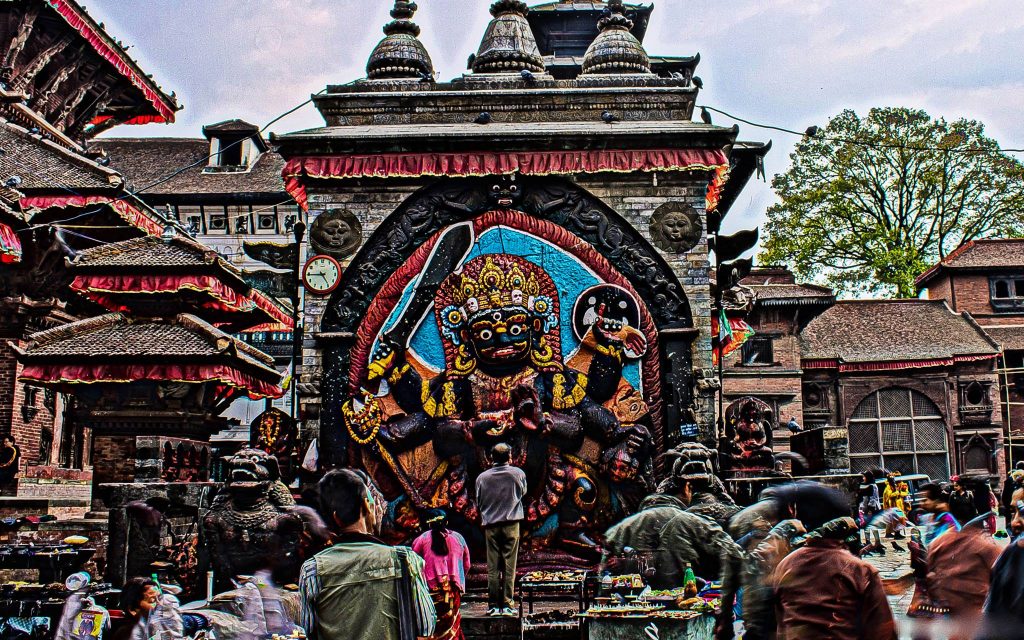
This huge stone image of Bhairav represents Shiva in his destructive manifestation, hence its terrifying expression and the symbols of death and destruction. The image of Kal Bhairav is said to be standing upon the laid image of betal. The statue is wearing skull garland and other ornaments of serpents. The image was carved from a single stone, though the portion on the upper right side was damaged and repaired by adding another stone. The sun and the moon to the left and right and the heads of lions in the upper portion also seem to be later additions. Such large images made of a single block of stone are very rare in Nepal.
Indrapur
Next to the Kal Bhairav is the temple of Indrapur. This temple is made in a pagoda style architecture, which stands on two plinths. The roof of the temple stands on four pillars on the end of which the sculptures of lions are beautifully carved. The temple only has the entrance in the south face of the temple.
Kotilingeshwor Mahadev Temple
North of Kal Bhairav is the stone made temple of Kotilingeshwor temple, which is built by King Mahendra Malla during 16th or 17th century. This temple is built in shikhara style architecture. Which seems to be continuation of Lichchhavi period. The main shrine of the temple is the image of Shiva Lingam having four faced in four different directions. Some part of this temple was destructed during the earthquake of 1990 B.S but later on the temple was renovated.
Mahendrashwor Temple 
In the North West side is the temple of Mahendrashwor, King Mahendra Malla constructed this temple during 1618 B.S and hence is named Mahendrashwor. Inside the temple, a statue of shiva facing all four directions, well known as “Chatur Mukhi Shiva” is established. On the first plinth, a pair of stone carved lions guards the entrance, whereas on the second plinth a pair of metal made lions guards the entrance. All the struts of the temple resemble shaivism and small bells are hanged along the edges of the temple’s roof.
Hanuman Dhoka 
Probably the most interesting part of Kathmandu is the ancient Hanuman Dhoka Palace complex in the middle of the old city. It is the main entrance to the nasal chowk of the palace. The monkey god Hanuman is placed outside of the gate for the protection from the evilness. To the right of the image of Hanuman is the main door of the Hanuman Dhoka Palace. It is guarded by a pair of stone lions. Shiva sits on the lion to the right, while Shakti sits on the lioness to the left. These custodians undoubtedly date from Malla times; the golden door itself, however, is of a later period.
Nasal Chowk
Passing through the golden Door one enters Nasal Chowk, the largest of the ten courtyards found inside Hanuman Dhoka palace. Many of the buildings that surround this courtyard date from the Shah Period but fair proportions of them also date from an earlier period. Most of the art objects and image found in Nasal Chowk date from the Malla period. On the eastern side of Nasal Chowk there is a small shrine of Nasaleshwar, from which the courtyard gets its name. During the Malla period, nasal chowk served, among other purpose as a sort of royal theatres. However, during the Shah period Nasal Chowk took even greater importance as the coronation of the Kings of Nepal has subsequently been held there. The Nasal Chowk courtyard is rectangular and the main entrance is situated at the northern end. Immediately to the left is the open audience chamber of the Malla kings, consisting of the old Malla throne. At the far end, rising a full nine storied, is the Basantapur Palace, built by King Prithivi Narayan Shah after his conquest of the valley.
Mohan Chowk
To the north of Nasal Chowk lies Mohan Chowk, the residence of the Malla Kings of Kathmandu. It was built in 1649 by King Pratap Malla and later renovated and modernized during the reign of King Rajendra Bikram Shah in 1822. One of the central features of Mohan Chowk is the Sundhara or golden water spout. The Sundhara ia about 3.5 meters below ground level. The spout itself is artistically carved while the walls around it are lined with thirty-six images of gods and goddesses, all of them beautiful works of art. There are two rows of images affixed to the wall. The images in the upper row show the ten incarnations of Vishnu and various scenes of Krishna at play, all perfectly in keeping images commemorating one of the earliest contacts between Kathmandu and the West.
Sundari Chowk
The Sundari Chowk of Hanuman Dhoka Durbar Square is the beautiful place to visit situated beside the Mohan Chowk. There are two entrances to this courtyard one from the Mohan Chowk and other from the Trishul Chowk. The doors and windows that we can find in this place are made on the basis of Nepalese Architecture. A like Mohan Chowk we can see the stone tap placed in this courtyard. On the basis of the inscription written in the bell found in this place we can say that this courtyard was made by King Pratap Malla. On the north-west side of the courtyard the statue of Lakshya Pratapeshwar is situated which was place by King Pratap Malla. There are many statues of Gods and goddesses placed in this courtyard but the numbers of statues are less in comparison to the Mohan Chowk. In the past people used to fill the water from this very tap situated in Sundar Chowk. In front of the stone tap situated is the sculpture of “Kalia Daman” (Lord Krishna’s victory over Kalia the evil serpent). In this sculpture the statue of Kalia serpent is portrayed in the form of human. On the forehead of this serpent lord Krishna is standing. It is believed that the statue was made in the 17th or the 18th Century, but till now there is no any evidence regarding the exact period.
Gaddi Baithak
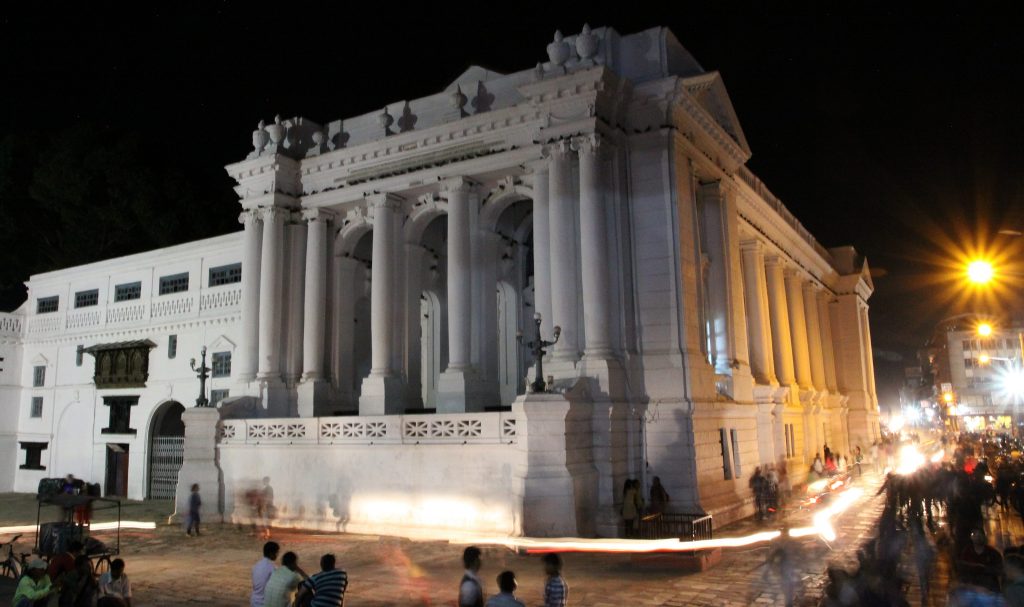
Gaddi Baithak is the white building situated in front of the Kumari Ghar. It is the building made by the prime minister Junga Bahadur Rana after his visit to England. This whole building is constructed under the influence of the British architecture. Now –a-days this place is opened on the day of Indra Jatra from where the politically important personnel from within and outside the country gather and observe the Indra Jatra festival.
Kumari Ghar
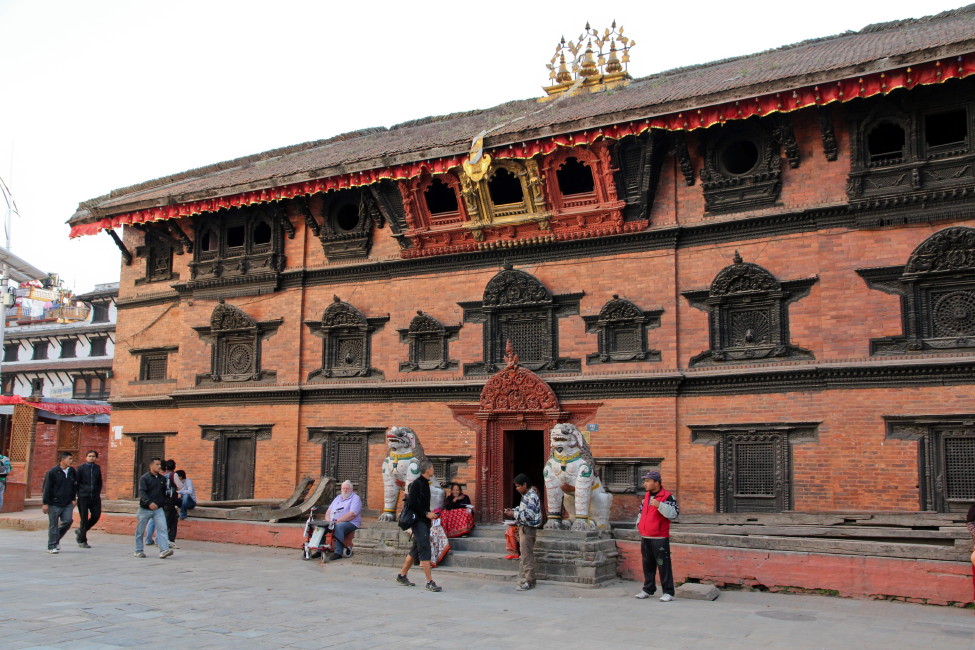
The Kumari Ghar is one of the major attraction of the complex. It is made in the Vihara architecture and is home to the only living goddess in the world. The building carried a huge importance in the art and architecture of the country as it displays the fine example of the wooden and the terracotta art. The windows and the torans (tympanum) as well as the sculptures displayed in the inner courtyard is a work of art made by the talented artists of that period is worth a look.
Basantapur Chowk
At the south-east corner of the Nasal Chowk is a doorway through which one can pass into Basantapur Chowk. The nine-storey Palace of Prithivi Narayan Shah consists of four towers representing four prominent cities of that time. Basantapur Tower, is on the south-west, Lalitpur Tower south-east corner, Bhaktapur Tower is on the north-east corner, while Kirtipur Tower is on the north-west. It is a mark of pride today that King Prithivi Narayan Shah built his Kathmandu Palace in the Nepalese style, showing his appreciation for the merits of the traditional architecture of the valley and also establishing a precedent for the coming centuries. The Basantapur Palace is a work of art in its own right, known for its finely carved roof struts, excellent windows, and poetry of roof rising upon roof.
Taleju Mandir

Built in 1564 by King Mahendra Malla, this is the most famous of the three Taleju temples built by the Malla kings. It is situated in Trishul Chwok, an appendage of Hanuman Dhoka Palace, but can also be approached by way of this Singha Dhoka or Lion Gate. The temple stands over 36.6 meters high, resting on a twelve-stage plinth. Its three roofs soar above the rest of the Hanuman Dhoka complex and until very recent times, it was considered very inauspicious to build a house higher than this temple. At the eight stage of the plinth, the step broadens out into a spacious platform on which a wall is mounted, barring further progress. On the platform just outside this wall there are twelve, miniature temples each with a double roof and all other appurtenances of a temple built in the Nepalese style. The same theme is repeated inside the wall, where there are four more such temples, each having a spire, one of the symbols of the attributes of goddess Taleju. On the south side, where the main door is found, there are large stone images of men and beasts, each one a powerful protecting force. At the top, on the final stage of the plinth, is a finely wrought bell on either side of the main door of the temple, one placed by Pratap Malla and other by Bhaskar Malla. They are rung only when worship is offered to goddess Taleju.
Mul Chowk
Mul Chowk was the scene of almost all the truly important functions of the Malla period. Religious rites of all descriptions, royal weddings, and the investiture of the crown prince as well as the coronation of all the Malla Kings took place here. Mul Chowk is shaped very much like a vihar or Buddhist monastery, with a square courtyard surrounded by a two-storied quadrangle. The southern wing of the quadrangle is by far the most important, housing a second and smaller temple of Taleju. On the ground floor of the three wings of the quadrangle there are large, open verandas. In the centre of the courtyard there is a low post set in the ground where animals are scarified at Dashain Festival. The temple is on the south side of Mul Chowk, facing north. To the right and left of its golden door, life-sized images of Ganga and Jamuna stand in poses of graceful service. Above the door, an impressive torana is placed on the honor of goddess taleju.
Agamchen
 Behind the statue of Hanuman, is a white building with a long balcony, upon which stands a three storied building known as Agamchen. This is situated in one corner of the Mohan Chowk. Inside this temple is placed an Agam Dyo a secret deity worshipped only by Malla Kings. The pinnacle is one of its distinct features, unlike other temples its pinnacle is not made in the kalash form but it portrays the miniature form of metal made Krishna Mandir of Lalitpur Durbar Square made in shikhara style
Behind the statue of Hanuman, is a white building with a long balcony, upon which stands a three storied building known as Agamchen. This is situated in one corner of the Mohan Chowk. Inside this temple is placed an Agam Dyo a secret deity worshipped only by Malla Kings. The pinnacle is one of its distinct features, unlike other temples its pinnacle is not made in the kalash form but it portrays the miniature form of metal made Krishna Mandir of Lalitpur Durbar Square made in shikhara style
architecture.
Pancha Mukhi Hanuman Mandir
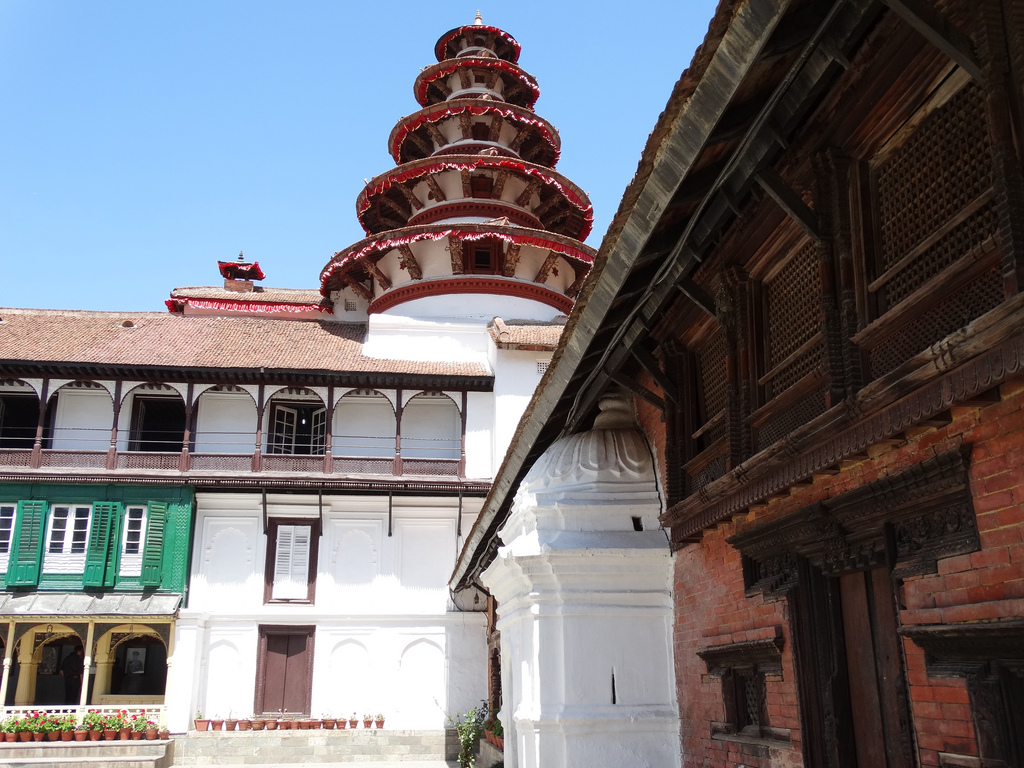
On the east side of Nasal Chowk, a five storied temple is situated which is known as Pancha Mukhi Hanuman. This temple has a distinct importance in the Nepalese history, unlike other temple this temple is made in a circular form. This temple has a statue of Pancha Mukhi Hanuman which is worshipped daily following a secret ritual. None except the priest of the temple can enter it hence the structure of the statue cannot be described.
Freak Street
Freak Street is the real name of Jhochem and it runs south of Basantapur Square. There are still plenty of restaurants and old lodges, it was the heart of old city.
Stone Column
To the left of the main entrance to the Hanuman Durbar Square and set in the outer walls of Mohan Chowk, there is a long stone slab with 15 different language scripts engraved on it. Installed by King Pratap Malla in 774 Nepal Sambat (17th century AD), the inscription is fenced inside maroon wooden flanks at present. Different languages such as English, French, Persian, Arabic, Maithili, Kiranti, Newari, Kayathinagar (script of the then west Nepal), Devanagri, Gaudiya, Kashmiri (Punjabi script family), Sanskrit and two different types of Tibetan scripts have been inscribed on the slab.


